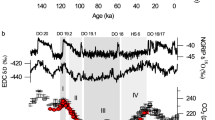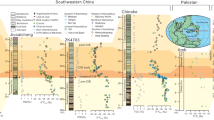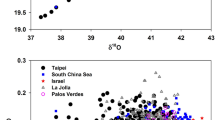Abstract
Reconstructions of atmospheric CO2 concentrations based on Antarctic ice cores1,2 reveal significant changes during the Holocene epoch, but the processes responsible for these changes in CO2 concentrations have not been unambiguously identified. Distinct characteristics in the carbon isotope signatures of the major carbon reservoirs (ocean, biosphere, sediments and atmosphere) constrain variations in the CO2 fluxes between those reservoirs. Here we present a highly resolved atmospheric δ13C record for the past 11,000 years from measurements on atmospheric CO2 trapped in an Antarctic ice core. From mass-balance inverse model calculations3,4 performed with a simplified carbon cycle model, we show that the decrease in atmospheric CO2 of about 5 parts per million by volume (p.p.m.v.). The increase in δ13C of about 0.25‰ during the early Holocene is most probably the result of a combination of carbon uptake of about 290 gigatonnes of carbon by the land biosphere and carbon release from the ocean in response to carbonate compensation of the terrestrial uptake during the termination of the last ice age. The 20 p.p.m.v. increase of atmospheric CO2 and the small decrease in δ13C of about 0.05‰ during the later Holocene can mostly be explained by contributions from carbonate compensation of earlier land-biosphere uptake and coral reef formation, with only a minor contribution from a small decrease of the land-biosphere carbon inventory.
This is a preview of subscription content, access via your institution
Access options
Subscribe to this journal
Receive 51 print issues and online access
$199.00 per year
only $3.90 per issue
Buy this article
- Purchase on Springer Link
- Instant access to full article PDF
Prices may be subject to local taxes which are calculated during checkout



Similar content being viewed by others
References
Monnin, E. et al. Atmospheric CO2 concentrations over the last glacial termination. Science 291, 112–114 (2001)
Flückiger, J. et al. High-resolution Holocene N2O ice core record and its relationship with CH4 and CO2 . Glob. Biogeochem. Cycles 16 1010 10.1029/2001GB001417 (2002)
Joos, F. & Bruno, M. Long-term variability of the terrestrial and oceanic carbon sinks and the budgets of the carbon isotopes 13C and 14C. Glob. Biogeochem. Cycles 12, 277–295 (1998)
Bruno, M. & Joos, F. Terrestrial carbon storage during the past 200 years: a Monte Carlo analysis of CO2 data from ice core and atmospheric measurements. Glob. Biogeochem. Cycles 11, 111–124 (1997)
Lüthi, D. et al. High-resolution carbon dioxide concentration record 650,000–800,000 years before present. Nature 453, 379–382 (2008)
Sigman, D. M. & Boyle, E. A. Glacial/interglacial variations in atmospheric carbon dioxide. Nature 407, 859–869 (2000)
Indermühle, A. et al. Holocene carbon-cycle dynamics based on CO2 trapped in ice at Taylor Dome, Antarctica. Nature 398, 121–126 (1999)
Joos, F., Gerber, S., Prentice, I. C., Otto-Bliesner, B. L. & Valdes, P. J. Transient simulations of Holocene atmospheric carbon dioxide and terrestrial carbon since the Last Glacial Maximum. Glob. Biogeochem. Cycles 18 GB2002 10.1029/2003GB002156 (2004)
MacDonald, G. M. et al. Rapid early development of circumarctic peatlands and atmospheric CH4 and CO2 variations. Science 314, 285–288 (2006)
Ruddiman, W. F. The anthropogenic greenhouse era began thousands of years ago. Clim. Change 61, 261–293 (2003)
Strassmann, K. M., Joos, F. & Fischer, G. Simulating effects of land use changes on carbon fluxes: past contributions to atmospheric CO2 increases and future commitments due to losses of terrestrial sink capacity. Tellus B 60, 583–603 (2008)
Brovkin, V., Kim, J. H., Hofmann, M. & Schneider, R. A lowering effect of reconstructed Holocene changes in sea surface temperatures on the atmospheric CO2 concentration. Glob. Biogeochem. Cycles 22 GB1016 10.1029/2006GB002885 (2008)
Berger, W. H. Increase of carbon dioxide in the atmosphere during deglaciation—the coral-reef hypothesis. Naturwissenschaften 69, 87–88 (1982)
Ridgwell, A. J., Watson, A. J., Maslin, M. A. & Kaplan, J. O. Implications of coral reef buildup for the controls on atmospheric CO2 since the Last Glacial Maximum. Paleoceanography 18, 1083–1092 (2003)
Broecker, W. S., Lynch-Stieglitz, J., Clark, E., Hajdas, I. & Bonani, G. What caused the atmosphere's CO2 content to rise during the last 8000 years? Geochem. Geophys. Geosyst. 2 1062 10.1029/2001GC000177 (2001)
Brovkin, V. et al. Carbon cycle, vegetation, and climate dynamics in the Holocene: experiments with the CLIMBER-2 model. Glob. Biogeochem. Cycles 16 10.1029/2001GB001662 (2002)
Smith, H. J., Fischer, H., Wahlen, M., Mastroianni, D. & Deck, B. Dual modes of the carbon cycle since the Last Glacial Maximum. Nature 400, 248–250 (1999)
Leuenberger, M., Siegenthaler, U. & Langway, C. C. Carbon isotope composition of atmospheric CO2 during the last ice-age from an Antarctic ice core. Nature 357, 488–490 (1992)
Eyer, M. Highly Resolved δ13C Measurements on CO2 in Air from Antarctic Ice Cores. 1–113, PhD thesis, Univ. Bern (2004)
Lourantou, A. Contraindre l'Augmentation en Dioxyde de Carbone (CO2) lors des Déglaciations Basés sur son Rapport Isotopique Stable du Carbone (δ13CO2). PhD thesis, Univ. Joseph Fourier (2008)
Loulergue, L. et al. New constraints on the gas age-ice age difference along the EPICA ice cores, 0–50 kyr. Clim. Past 3, 527–540 (2007)
Francey, R. J. et al. A 1000-year high precision record of δ13C in atmospheric CO2 . Tellus B 51, 170–193 (1999)
Schurgers, G. et al. Dynamics of the terrestrial biosphere, climate and atmospheric CO2 concentration during interglacials: a comparison between Eemian and Holocene. Clim. Past 2, 205–220 (2006)
Vecsei, A. & Berger, W. H. Increase of atmospheric CO2 during deglaciation: constraints on the coral reef hypothesis from patterns of deposition. Glob. Biogeochem. Cycles 18 GB1035 10.1029/2003GB002147 (2004)
Smith, L. C. et al. Siberian peatlands a net carbon sink and global methane source since the early Holocene. Science 303, 353–356 (2004)
Kim, J. H. et al. North Pacific and North Atlantic sea-surface temperature variability during the holocene. Quat. Sci. Rev. 23, 2141–2154 (2004)
Wang, Y., Mysak, L. A. & Roulet, N. T. Holocene climate and carbon cycle dynamics: experiments with the ''green'' McGill Paleoclimate Model. Glob. Biogeochem. Cycles 19 GB3022 10.1029/2005GB002484 (2005)
Beilman, D. W., MacDonald, G. M., Smith, L. C. & Reimer, P. J. Carbon accumulation in peatlands of West Siberia over the last 2000 years. Glob. Biogeochem. Cycles 23 GB1012 10.1029/2007GB003112 (2009)
Duplessy, J. C. et al. Deepwater source variations during the last climatic cycle and their impact on the global deepwater circulation. Paleoceanography 3, 343–360 (1988)
Crowley, T. J. Ice-age terrestrial carbon changes revisited. Glob. Biogeochem. Cycles 9, 377–389 (1995)
Acknowledgements
This work is a contribution to the European Project for Ice Coring in Antarctica (EPICA), a joint European Science Foundation/European Commission scientific programme, funded by the EU (EPICA-MIS) and by national contributions from Belgium, Denmark, France, Germany, Italy, the Netherlands, Norway, Sweden, Switzerland and the United Kingdom. The main logistic support was provided by IPEV and PNRA (at Dome C) and AWI (at Dronning Maud Land). We thank A. Landais, D. Rodriguez, E. Capron and G. Dreyfus for the contribution of δ15N data as well as P. Nyfeler and K. Grossenbacher for their technical support, T. Tschumi for sharing his Bern3D results, and J. Chappellaz for comments. We acknowledge financial support by the Swiss NSF, the DFG priority programme INTERDYNAMIK and the German climate programme DEKLIM. This is EPICA publication no. 227.
Author Contributions J.E., J.S., D.L., R.S. and M.E. performed the measurements. F.J. performed modelling and interpretation. M.L., H.F. and T.F.S designed the research. All authors participated in discussions on method development, interpretation and presentation of results.
Author information
Authors and Affiliations
Corresponding author
Supplementary information
Supplementary Information
This file contains Supplementary Methods, a Supplementary Discussion, Supplementary Notes, Supplementary References, Supplementary Tables ST1-ST2 and Supplementary Figures S1-S7 with Legends. (PDF 467 kb)
Rights and permissions
About this article
Cite this article
Elsig, J., Schmitt, J., Leuenberger, D. et al. Stable isotope constraints on Holocene carbon cycle changes from an Antarctic ice core. Nature 461, 507–510 (2009). https://doi.org/10.1038/nature08393
Received:
Accepted:
Issue Date:
DOI: https://doi.org/10.1038/nature08393
This article is cited by
-
Tropical decadal variability in nutrient supply and phytoplankton community in the Central Equatorial Pacific during the late Holocene
Scientific Reports (2024)
-
Soil depth gradients of organic carbon-13 – A review on drivers and processes
Plant and Soil (2024)
-
Multi-proxy constraints on Atlantic circulation dynamics since the last ice age
Nature Geoscience (2023)
-
Multiple carbon cycle mechanisms associated with the glaciation of Marine Isotope Stage 4
Nature Communications (2022)
-
Increased interglacial atmospheric CO2 levels followed the mid-Pleistocene Transition
Nature Geoscience (2022)
Comments
By submitting a comment you agree to abide by our Terms and Community Guidelines. If you find something abusive or that does not comply with our terms or guidelines please flag it as inappropriate.



